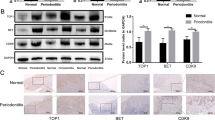Abstract
In the present study, phosphorylation of signal transducers and activators of transcription 3 (STAT3) was found to be important in the induction of G1 cell cycle arrest in murine macrophages infected with Aggregatibacter actinomycetemcomitans. First, we focused on suppressor of cytokine signaling 3 (SOCS3) as a negative regulator of the JAK/STAT pathway. Flow cytometric analysis showed that A. actinomycetemcomitans infection eliminated G1 cell cycle arrest in SOCS3-overexpressing RAW 264.7 macrophage cells. Western blotting analysis demonstrated expression of cell cycle-associated protein p21 and hypophosphorylation of retinoblastoma protein (Rb) was decreased in SOCS3-overexpressing RAW 264.7 cells. AG490, a specific inhibitor of JAK2, inhibited the expression of p21 and degradation of cyclin D1 in A. actinomycetemcomitans-infected RAW 264.7 cells, resulting in suppression of STAT3 phosphorylation. These results indicated that constitutive SOCS3 expression and AG490 inhibited the expression of JAK2 and phosphorylation of STAT3, and prevented cell cycle arrest in A. actinomycetemcomitans-infected RAW 264.7 cells. These findings suggest that the JAK/STAT pathway plays crucial roles in the cell cycle regulation of macrophages infected with periodontopathic bacteria through the suppression of p21 expression and degradation of cyclin D1.





Similar content being viewed by others
References
Menard R, Dehio C, Sansonetti P (1996) Bacterial entry into epithelial cells: the paradigm of Shigella. Trends Microbiol 4(6):220–226
Suzuki T, Franchi L, Toma C, Ashida H, Ogawa M, Yoshikawa Y, Mimuro H, Inohara N, Sasakawa C, Nuñez G (2007) Differential regulation of caspase-1 activation, pyroptosis, and autophagy via Ipaf and ASC in Shigella-infected macrophages. PLoS Pathog 3(8):1082–1091
Suzuki T, Núñez G (2008) A role for Nod-like receptors in autophagy induced by Shigella infection. Autophagy 4(1):73–75
Sreenivasan PK, Meyer DH, Fives-Taylor PM (1993) Requirements for invasion of epithelial cells by Actinobacillus actinomycetemcomitans. Infect Immun 61(4):1239–1245
Nishihara T, Koseki T (2004) Microbial etiology of periodontitis. Periodontol 2000 36:14–26
Kato S, Muro M, Akifusa S, Harada N, Semba I, Fujii T, Kowashi Y, Nishihara T (1995) Evidence for apoptosis of murine macrophages by Actinobacillus actinomycetemcomitans infection. Infect Immun 63(10):3914–3919
Muro M, Koseki T, Akihusa S, Kato S, Kowashi Y, Ohsaki Y, Yamato K, Nishijima M, Nishihara T (1997) Role of CD14 molecules in internalization of Actinobacillus actinomycetemcomitans by macrophages and subsequent induction of apoptosis. Infect Immun 65(4):1147–1151
Kasai H, Nakashima K, Yokota M, Nishihara T (2010) The G1 cell cycle arrest of macrophages infected with Aggregatibacter actinomycetemcomitans. Oral Dis 16(3):305–309
Weinberg RA (1995) The retinoblastoma protein and cell cycle control. Cell 81(3):323–330
Matsushime H, Roussel MF, Ashmun RA, Sherr CJ (1991) Colony-stimulating factor 1regulates novel cyclins during the G1 phase of the cell cycle. Cell 65(4):701–713
Naka T, Narazaki M, Hirata M, Matsumoto T, Minamoto S, Aono A, Nishimoto N, Kajita T, Taga T, Yoshizaki K, Akira S, Kishimoto T (1997) Structure and function of a new STAT-induced STAT inhibitor. Nature 387(6636):924–929
Yoshimura A, Naka T, Kubo M (2007) SOCS proteins, cytokine signaling and immune regulation. Nat Rev Immunol 7(6):454–465
Nicholson SE, Souza DD, Fabri LJ, Corbin J, Willson TA, Zhang J-G, Silva A, Asimakis M, Farley A, Nash AD, Metcalf D, Hilton DJ, Nicola NA, Baca M (2000) Suppressor of cytokine signaling-3 preferntially binds to the SHP-2-binding site on the shared cytokine receptor subunit gp130. Proc Natl Acad Sci USA 97(12):6493–6498
Sasaki A, Yasukawa H, Shouda T, Kitamura T, Dikic I, Yoshimura A (2000) CIS3/SOCS-3 suppresses erythropoietin (EPO) signaling by binding the EPO receptor and JAK2. J Biol Chem 275(38):29338–29347
Schmitz J, Weissenbach M, Haan S, Heinrich PC, Schaper F (2000) SOCS3 exerts its inhibitory function on interleukin-6 signal transduction through the SHP2 recruitment site of gp130. J Biol Chem 275(17):12848–12856
Alexander WS (2002) Suppressors of cytokine signaling (SOCS) in the immune system. Nat Rev Immunol 2(6):410–416
Chen PL, Scully P, Shew JY, Wang JYJ, Lee WH (1989) Phosphorylation of the retinoblastoma gene product is modulated during the cell cycle and cellular differentiation. Cell 58(6):1193–1198
Germain D, Frank DA (2007) Targeting the cytoplasmic and nuclear functions of signal transducers and activators of transcription 3 for cancer therapy. Clin Cancer Res 13(19):5665–5669
Valentino L, Pierre J (2006) JAK/STAT signal transduction: regulators and implication in hematological malignancies. Biochem Pharmacol 71(6):713–721
Smirnova OV, Ostroukhova TY, Bogorad RL (2007) JAK/STAT pathway in carcinogenesis: is it relevant to cholangiocarcinoma progression? World J Gastroenterol 13(48):6478–6491
Baetz A, Frey M, Heeg K, Dalpke HA (2004) Suppressor of cytokine signaling (SOCS) proteins indirectly regulate Toll-like receptor signaling in innate immune cells. J Biol Chem 279(52):54708–54715
Kasai H, Yamamoto K, Koseki T, Yokota M, Nishihara T (2004) Involvement of caspase activation through release of cytochrome c from mitochondria in apoptotic cell death of macrophages infected Actinobacillus actinomycetemcomitans. FEMS Microbiol Lett 233(1):29–35
Lu Y, Fukuyama S, Yoshida R, Kobayashi T, Saeki K, Shiraishi H, Yoshimura A, Takaesu G (2006) Loss of SOCS3 gene expression converts STAT3 function from anti-apoptotic to pro-apoptotic. J Biol Chem 281(1):36683–36690
Akifusa S, Kamino N, Shimazaki Y, Yamaguchi N, Nonaka K, Yamashita Y (2010) Involvement of the JAK-STAT pathway and SOCS3 on the regulation of Adiponectin-generated reactive oxygen species in murine macrophage RAW 264 cells. J Cell Biochem 111(3):597–606
Dongari-Bagtzoglou AI, Ebersole JL (1996) Production of inflammatory mediators and cytokines by human gingival fibroblasts following bacterial challenge. J Periodontal Res 31(2):90–98
Moran DM, Mattocks MA, Cahill PA, Koniaris LG, McKillop IH (2007) Interleukin-6 (IL-6) mediates G0/G1 growth arrest in hepatocellular carcinoma through a stat 3-dependent pathway. J Surg Res 147(1):23–33
Acknowledgments
This work was supported in part by Grants-in-Aid for Scientific Research (23792149), from the Ministry of Education, Culture and Science of Japan.
Author information
Authors and Affiliations
Corresponding author
Rights and permissions
About this article
Cite this article
Okinaga, T., Ariyoshi, W., Akifusa, S. et al. Essential role of JAK/STAT pathway in the induction of cell cycle arrest in macrophages infected with periodontopathic bacterium Aggregatibacter actinomycetemcomitans . Med Microbiol Immunol 202, 167–174 (2013). https://doi.org/10.1007/s00430-012-0282-x
Received:
Accepted:
Published:
Issue Date:
DOI: https://doi.org/10.1007/s00430-012-0282-x




